Welcome to the ultimate battle of the titans, the Michelin Crossclimate 2 versus the Michelin Defender 2. These two boys, designed for all-season use, on everything from sedans to SUVs, are stepping into the ring to show you what they’ve got.
The Crossclimate 2, a phenomenal mixture, or say fusion of a summer and winter tire, carries the 3PMSF rating with pride and is ready to astonish you with its impressive dry road grip. It’s a tire that doesn’t believe in the off-season and proves its worth on both sun-drenched asphalt and treacherous snowy paths.
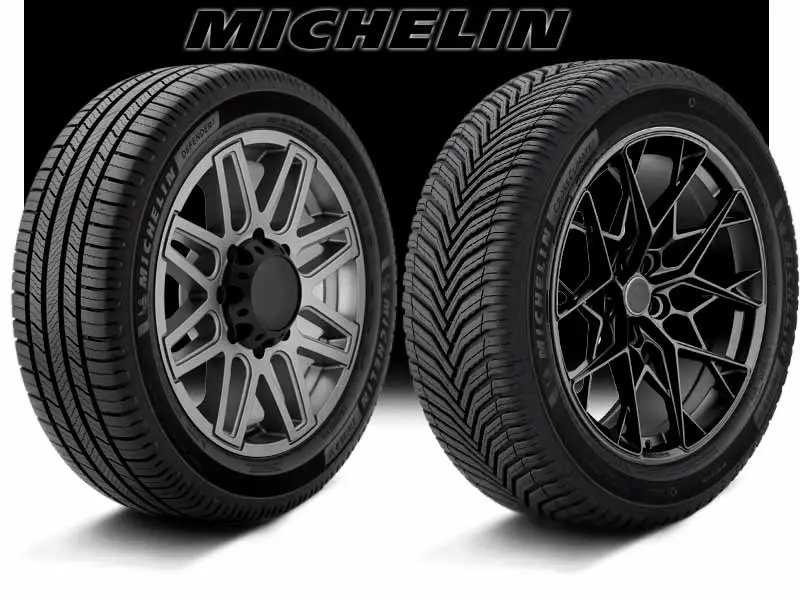
In the opposing corner, we have the Michelin Defender. With its unparalleled comfort, stellar fuel efficiency, superior tread wear, and outstanding wet traction, this tire doesn’t just excel, it sets the bar. It’s a tire that makes no compromises when it comes to delivering a smooth, secure ride, no matter the weather.
Are you ready to dive deeper into the world of these premium tires and see how they measure up? Let’s roll and start by exploring their sizes info.
Table of Contents
Tire Sizes Facts
The Michelin Defender 2 currently comes in 33 total sizes, while the Crossclimate 2 provides you with 89 total sizes, where it showcases superior speed and load rating.
| Defender 2 | Crossclimate 2 | |
| Sizes | 16 to 20″ | 16 to 22″ |
| Speed Rating | H (on all) | H and V |
| Load Range | 1356 to 2149 lbs | 1356 to 2601 lbs |
| Weight Range | 25 to 32 lbs | 25 to 36.5 lbs |
| Tread Depth | 10.5/32″ (on all) | 10/32″ (on all) |
| Section Width | 8 to 10″ | 8 to 11″ |
| 3PMSFR | No | Yes |
Side Note: Make sure you also check out Michelin Defender LTX MS vs CrossClimate 2.
Side By Side Comparison
Michelin Defender 2
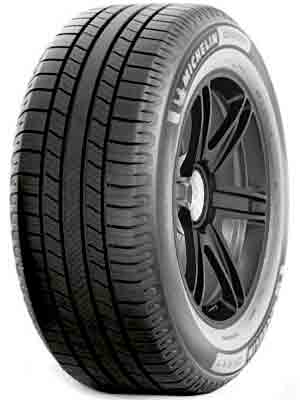
Michelin Crossclimate 2
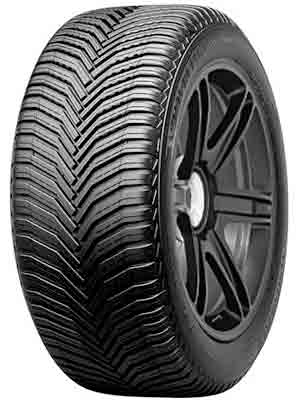
The Michelin Defender 2 gives you a very straight forward design of a continuous central rib (highlighted with red) and surrounding blocks with similar siping pattern.
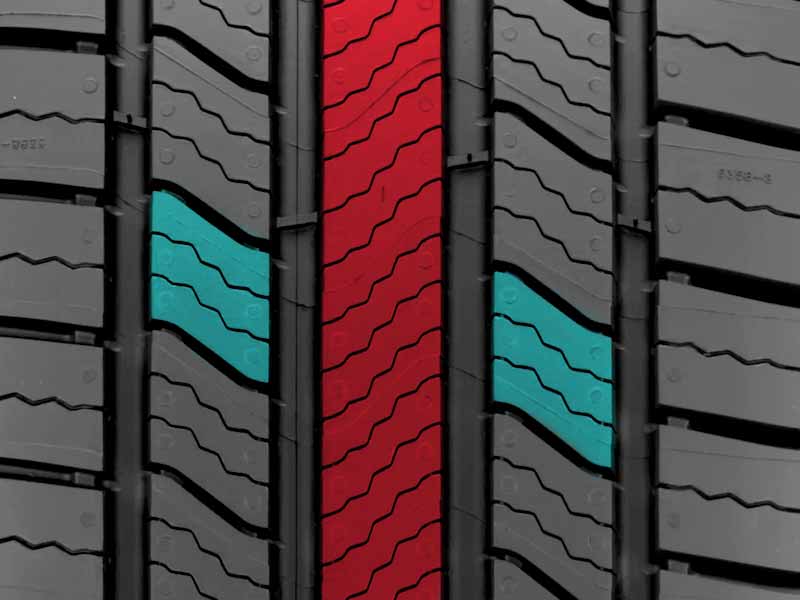
These sipes are interlocking and full depth, so they provide very considerable wet traction, and with consistent rib in the middle, the tire also provides enhanced on road dry traction as well.
And although the surrounding blocks (highlighted with the color blue) are clearly dividing with wave like lateral grooves, they still have connectors in between, which improve braking and handling stability (especially on dry).
Together all these blocks make 4 circumferential channels, which are almost similar in width, and they provide ample hydroplaning resistance.
On the other hand, the Michelin Crossclimate 2 features a directional tread pattern, with a very impressive design, with which it covers all key areas of on road performance.

The long swooping arms interconnect with each other and provide ample dry grip, while the interlocking sipes in the very middle provide efficient water cleaning.
These lugs also provide amazing winter traction with notches and slits where snow get trapped (so the tread makes better snow to snow contact), earning this tire with 3 peak mountain snowflake rating (along with M+S).
If we move towards the shoulders, the Michelin Defender 2 focuses on dry traction a lot, as each block carry connectors in between which act as reinforced supports and provide lateral stability and better contact patch (to meet the road, resulting in to grip).
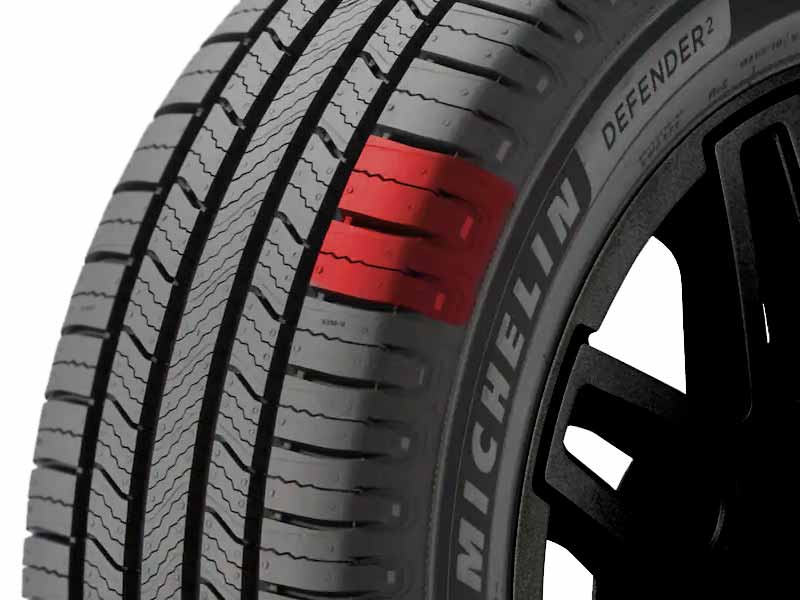
The siping here is minimal, and forms a slightly different design, where it’s interlocking a first and then turns into a rectilinear shape, which then join the J shaped grooves (towards the sidewalls).
If we compare it with the shoulder blocks on Crossclimate 2, its design is more compact.
Crossclimate 2 with wider block valleys between the shoulder blocks, although does not make as much contact with the road, the tire sure provides ample grip with lateral slits embedded.
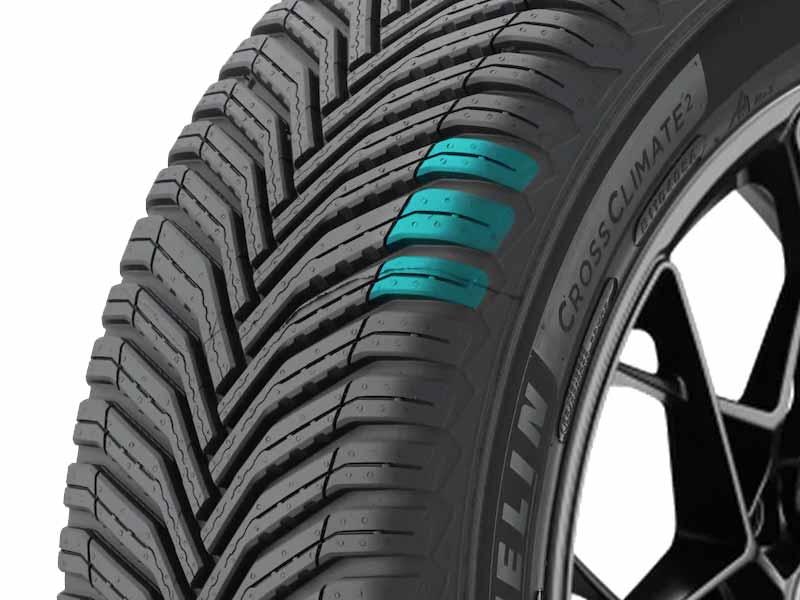
All it’s shoulder blocks get divided form the middle tread area with longitudinal slits as well, so the tire grip in both directions (lateral and circumferential).
Also note that all its shoulder blocks vary in sizes, to produce variable pitches.
Snow Performance
With 3 peak mountain snowflake rating, it’s obvious that the Crossclimate 2 is going to be better, but it’s not just that, it’s one of the best all season tire that you can get for winter performance.
This tire does everything right here.
The tire has more weight, so it puts more pressure on the snow, and try to lodge snow particles in it’s grooves.
And it’s notches and larger tread voids welcome snow to get lodged in very easily, providing this tire with superior snow to snow contact (which is preferred).
The tire also provides a softer rubber, which does not get stiffen up with lower temperatures.
On the other side, although Defender 2 also provides soft enough rubber, it lacks in biting edges and with it’s continuous rib in the middle, it’s not able to provide as much snow to snow contact.
On-Road Comfort
Where it compromises on durability, the Michelin Defender 2 becomes a very comfortable tire in return.
With less total number of polymer layers in it’s internal construction, it provides a very spongy tread, which absorbs the imperfections of the road very nicely.
In comparison, although the Michelin Crossclimate 2 provides you with quite a softer rubber, for winter traction purposes, the stiffer internal construction of the tire is not able to provide as much comfort performance on smooth as well as bumpy tarmacs.
Moreover, the tire also has less tread depth in comparison, and although it makes a slight difference, the Defender 2 gets to have a little bit of more rubber area to dissipate the bumps.
Tread Noise
Tread noise depends on the shoulder blocks a lot, that’s because, most of the air enters through there, which then hits the tread walls to produce noise. So, it makes sense why Michelin Defender 2 is so quiet on road.
With connectors between the shoulder blocks, this tire restricts the movement of the air flow, and this way, it’s able to dampen the noise levels, significantly.
The Michelin Crossclimate 2 on the other side, although provides you with variable pitch technology, the wider grooves still make a lot of noise.
But compared to other all season tires, it’s not very loud, as it’s directional design still get to provide a streamlined flow of air through it’s grooves.
FYI: With variable pitch, the tire provides variations in blocks which produce different sound frequencies and they try to cut down each other, and dampen the noise this way.
Dry Traction
Dry traction is divided in to two section, grip and handling, where grip is measured by calculating the breaking distances, (stopping the car from a certain speed, usually 50 mph), whereas the handling is calculated by noting down the lap times.
Now when it comes to these two tires, although both are great on road, the Michelin Crossclimate 2 provides better on road grip, while the Michelin Defender 2 gives you better handling times.
The Crossclimate 2 is basically a very well engineered, and although the tire has wider grooves, it’s rounded contact patch, makes a firmer contact from the middle, where the lugs are closely packed.
This rounded contact patch also enhances high speed stability as well, and that’s one of the main reasons, why this tire is rated up to V in speed rating, (compared to Defender 2, which only comes in H).
And although the tire lacks slightly in handling, the slits in it’s shoulder blocks act as biting edges and still provide satisfactory lateral traction values.
On the other side, the Michelin Defender 2 provides superb handling, with superior stability and steering response.
The tire is very light in weight and so it shows very little lag times between the steering inputs and the feedback.
It’s shoulder blocks (which come in to action during cornering), provide a better rubber to road contact in comparison, where all it’s blocks are closely packed & connected with each other with ridges in between, naturally increasing the tire’s handling capabilities.
Wet Traction
Wet traction provides a little different scenario, sure it depends on grip too, but major factors here include sipes and rubber composition.
So it’s not surprising to see Michelin Crossclimate 2 lacking here with less number of sipes, though they are very effective.
Most of the siping with this tire is seen in the middle, as that’s where the tire makes the most contact with the ground (having a rounded contact patch). But these sipes are not enough to clear water off in time.
Basically, sipes suck in the water particles underneath and shower it away as the tire rolls over, and as the tire does not provide enough siping (for the sake of grip), it’s wet traction is compromised.
On the other side, the Michelin Defender 2 not only provide more sipes, they also have 3D sipe lock technology as well, so with that, while cornering and braking these sipes interlock with each other and don’t get stiff.
And these sipes are already very flexible, with a softer composition and construction, so the tire provides better efficacy on wet roads.
Hydroplaning
Hydroplaning depends on water evacuation from the tread, and here although both tires are very effective, the Defender 2 provides better resistance on straight roads, while Croosclimate 2 provide better curved aquaplaning resistance.
In case of Michelin Crossclimate 2, the tire’s directional pattern with elongated lugs are designed in a way which pushes water out of it’s grooves with a streamlined flow, the open shoulder blocks provide ample space for water to easily gush in & out.
On the other side, the Defender 2 offers 4 wide longitudinal channels, that provides this tire with better float speeds (on straight roads).
And although the tire has the advantage of having extra tread depth, which allows larger volume of water to flow out, the closed up shoulder blocks don’t do so good during curved hydroplaning test, comparatively.
Fuel Efficiency & Tread Wear
Fuel economy and Tread wear of the tire, depends on a lot of factors, where weight, tread composition and design are the most noteworthy.
So, with more weight (in comparison), the Michelin Crossclimate 2 does not offer an optimized fuel efficiency.
The tire’s weight enforces it’s tread to put more pressure on the road, increasing overall rolling resistance and consuming more fuel as a result.
Michelin Defender 2 on the other hand, is better here as it provides less biting edges overall, and although this limits’ it’s winter traction, it produces lower rolling resistance values, and thus the tire consumes lesser fuel.
And of course, with just a single ply polyester construction, the tire gets to be very light too, so its asks for less energy to move.
It’s stiffer rubber, and more tread depth also accounts for its longevity as well, where it take a while to wear off in comparison.
That’s why it offers you with 80k warranty compared to 60k miles for Crossclimate 2.
Durability
Michelin takes a slightly different approach on durability with Defender 2.
Where usually tires get to have 2 ply polyester carcass, the Defender 2 only features a single ply polyester casing, which although limits the tire’s toughness, increases the grip capabilities at the same time.
It’s single ply polyester is then layered with 2 steel belts, which are then reinforced with a single cap ply of polyamide.
On the other side, the Michelin Crossclimate 2 features a 2 ply casing of polyester, with similar dual steel belts covered with a single ply of polyamide.
So the Defender 2 gets to have a single ply sidewalls, while the Crossclimate 2 is 2 ply, providing with a slightly better durability overall.
Off Road Traction
These tires can not handle off road, but out of them Michelin Crossclimate 2 is still more capable of performing in comparison.
But why?
Well, the tire like discussed above, offers superior durability, so its more reliable when you have to face any (mild) off-road scenarios.
Moreover, the CrossClimate 2 features slightly wider grooves, so dirt, a little bit of mud, or debris can pass through it more easily.
In contrast, the Defender 2 with its closed up tread voids, faces a harder time, and get packed with dirt/mud more easily, loosing all traction.
Though its best to keep them on the road.
Take Home Points
Embarking on a journey of tire exploration, we’ve delved deep into the world of the Michelin CrossClimate 2 and the Michelin Defender 2. And here each of these premium all-season tires brings its own unique strengths to the table.
With its 3PMSF rating, the CrossClimate 2 has proven itself a superior performer in snowy conditions, and it doesn’t fall short on wet and dry roads either.
However, if you’re seeking an overall enhanced on-road experience, the Defender 2 takes the lead.
It offers improved comfort, superior fuel economy, and increased mileage, although it makes slight compromises on winter performance.
Both tires have their distinct advantages, so your ultimate choice should depend on your specific needs and driving conditions.


